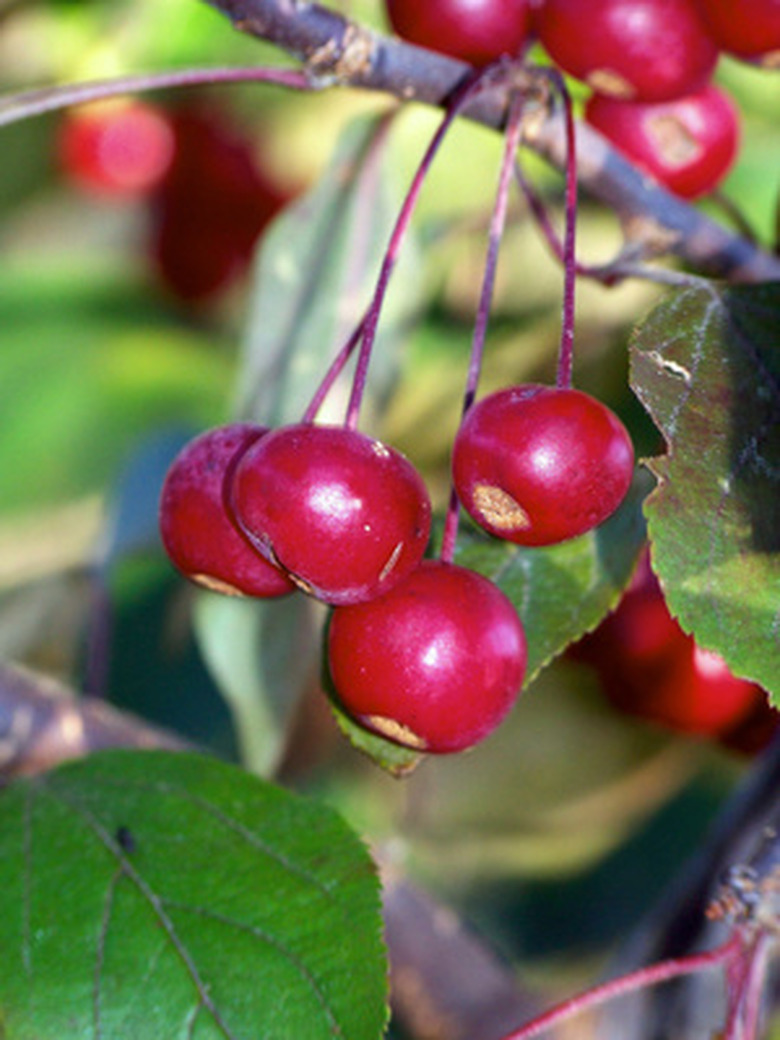Bag Worms On A Crabapple Tree
The bagworm, Thyripopteryx ephemeraeform, is an insect pest that infests some 128 species of trees and shrubs in the United States; the crabapple tree is one of its preferred hosts. The bagworm also infests maples, oaks, spruce, junipers, cedars and pines among others. Bagworm larvae moving about in protective bags do the most damage to the trees.
Appearance
Bagworm larvae are tan or brown mottled with black. The females remain larva-like, never leaving their bags. The adult males look like bees with fur-covered bodies and clear wings. The silken bags covering the larvae that do the most damage are about 1/8-inch long in the early spring.
- The bagworm, Thyripopteryx ephemeraeform, is an insect pest that infests some 128 species of trees and shrubs in the United States; the crabapple tree is one of its preferred hosts.
- The silken bags covering the larvae that do the most damage are about 1/8-inch long in the early spring.
Life Cycle
Male and female bagworms spend the winter inside their bags. Female bags contain several hundred eggs that hatch in late spring. The newly hatched larvae spin down on silken threads to settle on the host tree or, blown about by spring breezes, they land on a new tree.The larvae begin to eat, covering their bodies with silken bags that they take with them as they forage.The bags get larger as they add pieces of bark, twig and foliage, excrement and the skins that they shed. If larvae are disturbed, they yank their heads back inside their bags and close them tightly.
The larvae grow until August when the bags are about 2½ inches long. They stop feeding and attach themselves to a twig with loops of silk and close the bag. They molt into the pupal stage, and a month later the males emerge in quest of a female. After mating, the female deposits her eggs then drops to the ground and dies.
- Male and female bagworms spend the winter inside their bags.
- The larvae begin to eat, covering their bodies with silken bags that they take with them as they forage.
Bagworm Damage
Larvae may eat the crabapple buds causing branches to die and leaving open, dead areas. The mature larvae secure their bags by wrapping silk tightly around the branch. This band constricts the branch and can kill it after several years.
Cultural and Biological Control
Pick the bags off the tree and destroy them in the late fall after the crabapple tree has lost its leaves. Cut the silk band attaching the bag so the branch will not be girdled as it grows. Spray Bacillus thringiensis (Bt) on the larvae in the spring when they are young. Its toxins cause pores in the gut of susceptible larvae including the bagworm. Bt is environmentally friendly.
- Larvae may eat the crabapple buds causing branches to die and leaving open, dead areas.
Chemical Control
Insecticides registered by the Environmental Protection Agency to control bagworm include those with the active ingredients of acephate, bendiocarb, bifenthrin, carbaryl, chlopyrifos, cyfluthrin, diazinon, dimethoate, fluvalinate, malathion, nicotine sulfate, pyrethrum, permethrin, rotenone and trichlorfon. Spray in the early spring before the bagworms have had time to build impenetrable protective bags around themselves. Cover the entire branch with the insecticide; you have to get the larvae when they poke their heads out to eat.
